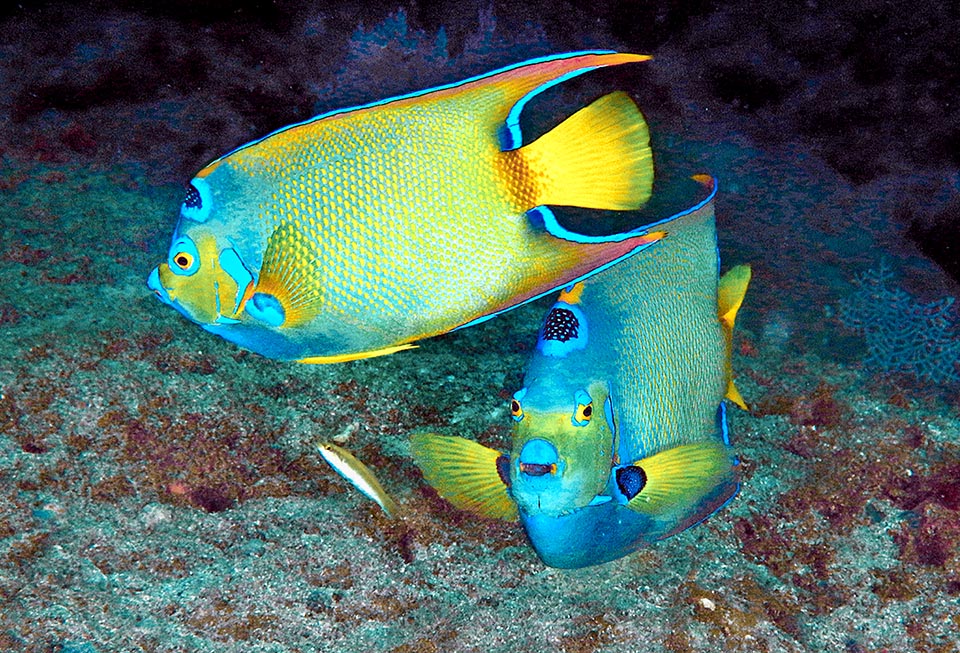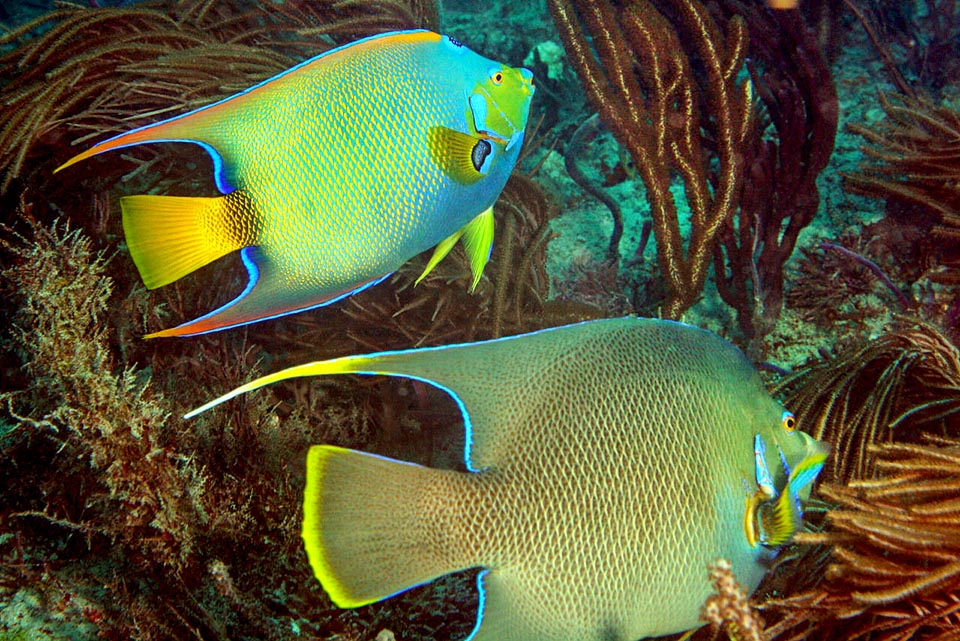Family : Pomacanthidae

Text © Giuseppe Mazza

English translation by Mario Beltramini

Up to 45 cm long, the varicoloured Holacanthus ciliaris lives in the West Atlantic Ocean tropical waters © Kevin Bryant
The Yellow angelfish (Holacanthus ciliaris Linnaeus, 1758), known also as Queen angelfish due to its crown-shaped drawing it has on the head, belongs to the class of Actinopterygii, the ray-finned fishes, to the order of Perciformes and to the family of Pomacanthidae, which counts 8 genera and 91 species.
The etymology of the genus Holacanthus comes from the Greek “olos”, entire, whole and “akantha”, spine to underline the great spine on the preoperculum and the presence of interopercular spines.

Like Holacanthus bermudensis has a big spine on the preoperculum and interopercular spines, but distinguishes for the blue small bar, over the eyes, similar to eyelashes © Kevin Bryant
The name of the species ciliaris comes from the Latin “cilium”, eyelash.
Zoogeography
It is present in the tropical waters of the western Atlantic Ocean.

Moreover, it has a black bordered blue zone on the pectorals and a dotted spot on the head, like a light blue edged crown, hence also the vulgar name of Queen angelfish. Left © Kevin Bryant, right © Giuseppe Mazza
Just to give an idea of its distribution, we find it from Florida and the Gulf of Mexico up to the Caribbean Sea and Brazil.
It is, therefore, at home in southern USA, in Mexico, Belize, Guatemala, Honduras, Nicaragua, Costa Rica, Panama, Colombia, Venezuela, Guyana, Surinam, French Guyana and Brazil, not to forget a crowd of islands, such as the Bahamas, Cuba, Haiti, Dominican Republic, Jamaica, Puerto Rico, Anguilla, St. Kitts and Nevis, Antigua and Barbuda, Guadeloupe, Dominica, Martinique, St. Lucia, St. Vincent, Barbados, Grenada, Trinidad and Tobago.

Furthermore, has a yellow tail and this dominant, often present on the body, in addition earned it the name of Golden angelfish © Giuseppe Mazza
Ecology-Habitat
It lives among the madrepores and the corals in shallow waters, but also at 70 m of depth on the outer side of the reefs.
It knows well the hiding places of its small territory and disappears moving with grace, immediately, as soon as the predators show up.
Morpho-physiology

In the adult specimens turquoise is sometimes intense with orange shades on the fins. It eats plankton, hydroids, bryozoans, ascidians, sponges, algae and phanerogams © François Libert
It can reach the length of 45 cm, but rarely exceeds the 36 cm.
The body is flat, almost oval, with the great dorsal fin and the anal one prolonging well beyond the tail. The first counts 14 spiny rays and 20-21 soft; the second, less elongated at the apex, has 3 spines and 20-21 unarmed rays.
The pectoral fins have 19 soft rays, and the ventral, unarmed, are long and pointed. The caudal, rounded n the juveniles, is more or less truncate in the adults.

A couple. Like Holacanthus bermudensis thousands of eggs are fecundated in open seas and seen that the ranges often do overlap, the hybrids are not rare © Kevin Bryant
The yellow and the blue colours are predominant in the livery, which is quite variable. The tail the pectoral fins and the ventral ones are always yellow and more or less yellow is the operculum zone.
Over the eye, on the back, stands a characteristic blue spot white dotted and emphasized, like a crown by an electric blue border, like that of the prolongations of the dorsal, separated, towards the apex, by a red zone.
Typical is also the blue spot at the base of the pectoral fins.

The two juvenile species, quite similar and behave as cleaner labrids, free the large fishes and the turtles from the parasites of the skin © Kevin Bryant
The body is greenish blue with the border of the scales yellow and when this hue becomes dominant, the vulgar epithet of yellow angelfish seems to be justified. In the adults having a certain age, on the contrary, the dark hues are dominant.
Over the eye, we note two small blue bars similar to an eyelash, as states the name of the species.
The livery of the juveniles is completely different, so much that in the past they talked about other species.

Here various liveries document the growth. No surprise if later so many synonyms were born © Kevin Bryant

Finally the crown makes its way and the lips turn blue, while the dorsal and anal fins stretch to the sides © Pauline Walsh Jacobson
The blue crown on the head is absent, the eye is crossed by a wide vertical, dark blue band bordered by electric blue and 2-3 blue electric vertical bands cross also the body, bluish in its whole, excepting the fore ventral zone, the lips and the tail, which are yellow.
Ethology-Reproductive Biology
The yellow angelfish lives solitary nou- rishing of phytoplankton, zooplankton and various benthic invertebrates, such as hydroids, bryozoa, ascidians and sponges, without forgetting some seaweeds and phanerogams of the submerged grasslands.

The two species, compared. Above, Holacanthus ciliaris, with its yellow caudal fin and the crown, and below Holacanthus bermudensis © Kevin Bryant
Usually, the males control a small territory where they allow only the females, absolutely similar but smaller, to enter.
The reproduction, by pairs, may take place all over the year and the eggs are pelagic.
Demanded like Holacanthus bermudensis by the aquaria market, it is also sporadically consumed by the fishermen of the Caribbean, careless of the risk of ciguatera, a serious alimentary intoxication related to the presence of poisonous organisms in its diet.

Finally, on top, the two species hybrid. The livery is darker, the crown has lost the dotting and the caudal fin is yellow only on the edges © Kevin Bryant
Populations in the wild can double in 1.4-4.4 years and the species, indicated as “Least Concern” on the IUCN Red List, is not currently at risk.
Synonyms
Angelichthys iodocus Jordan & Rutter, 1897; Chaetodon ciliaris Linnaeus, 1758; Chaetodon parrae Bloch & Schneider, 1801; Chaetodon squamulosus Shaw, 1796; Holacanthus coronatus Desmarest, 1823; Holacanthus formosus Castelnau, 1855; Holacanthus iodocus Jordan & Rutter, 1897.
→ For general information about FISH please click here.
→ For general information about BONY FISH please click here
→ For general information about CARTILAGINOUS FISH please click here.
→ To appreciate the BIODIVERSITY of BONY FISH please click here.
→ To appreciate the BIODIVERSITY of CARTILAGINOUS FISH please click here.
